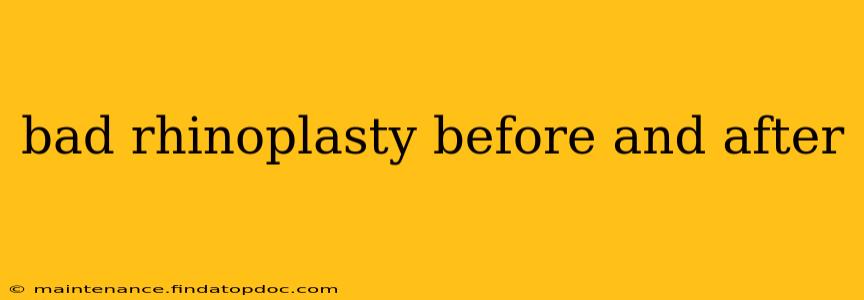Rhinoplasty, or a nose job, is one of the most popular cosmetic surgeries worldwide. While often yielding stunning results, it's crucial to understand that like any surgical procedure, rhinoplasty carries risks. This article explores the potential for negative outcomes following rhinoplasty, addressing common concerns and offering insights into revision surgery and preventative measures.
What Constitutes a "Bad" Rhinoplasty?
A "bad" rhinoplasty isn't simply a result that doesn't meet the patient's initial expectations. It signifies a result that negatively impacts the patient's appearance, breathing, or overall well-being. This could manifest in several ways:
- Asymmetry: One side of the nose appearing noticeably different from the other.
- Breathing Difficulties: Narrowed nasal passages leading to impaired breathing or snoring.
- Poor Tip Definition: A droopy, bulbous, or unnatural-looking nasal tip.
- Visible Implants or Sutures: Obvious signs of surgical intervention that detract from the natural appearance.
- Over- or Under-Resection: Removal of too much or too little cartilage, leading to an unnatural or undesirable shape.
- Skin Issues: Post-surgical scarring, skin irregularities, or skin necrosis (tissue death).
- Dissatisfaction with Overall Appearance: The final result doesn't align with the patient's goals or expectations, leaving them feeling unhappy with their appearance.
Why Do Bad Rhinoplasty Results Occur?
Several factors can contribute to unsatisfactory rhinoplasty outcomes:
- Inexperienced Surgeon: Lack of surgical skill and experience is a primary contributor.
- Unrealistic Expectations: Patients with unrealistic expectations may be disappointed even with a technically successful surgery.
- Inadequate Pre-operative Planning: Failure to properly assess the patient's anatomy and desired outcome.
- Poor Surgical Technique: Errors during the surgical procedure itself.
- Unexpected Healing Complications: Individual healing responses can vary, leading to unexpected results.
How Can I Avoid a Bad Rhinoplasty?
Thorough research and careful selection of your surgeon are paramount in preventing a negative outcome.
- Consult Multiple Surgeons: Meet with several board-certified plastic surgeons to discuss your goals and assess their expertise.
- Review Before-and-After Photos: Examine a surgeon's portfolio of actual patients, paying close attention to the naturalness of the results.
- Check Credentials: Verify the surgeon's board certification and experience in rhinoplasty.
- Realistic Expectations: Have an open and honest conversation with your surgeon about realistic outcomes and potential limitations.
- Open Communication: Maintain open communication with your surgeon throughout the entire process, expressing any concerns or questions.
What are the signs of a bad rhinoplasty before the final result?
While some issues only become apparent after the swelling subsides, some red flags might appear during the healing process. These include excessive pain, prolonged swelling, significant bruising, or difficulty breathing. Any concerning symptoms should be immediately reported to your surgeon.
What is revision rhinoplasty?
Revision rhinoplasty is surgery performed to correct a previous rhinoplasty that yielded unsatisfactory results. It’s generally more complex than an initial rhinoplasty due to scar tissue and potential challenges in reshaping the existing nasal structure. Choosing an experienced and highly skilled surgeon specializing in revision rhinoplasty is crucial for the best possible outcome.
Can I sue if I'm unhappy with my rhinoplasty?
Legal recourse for dissatisfaction with a cosmetic surgery outcome depends on several factors, including the surgeon's negligence, the severity of the complications, and the documentation of the pre-operative consultations and informed consent process. If you believe you have grounds for a legal claim, consult with a medical malpractice attorney.
How long does it take to recover from a bad rhinoplasty?
Recovery time from a bad rhinoplasty, especially a revision procedure, can be lengthy and varies depending on the complexity of the revision. Swelling and bruising may persist for several months, and complete healing can take a year or more.
Remember, choosing the right surgeon is the most critical step in achieving a positive outcome. Thorough research, open communication, and realistic expectations are key to a successful rhinoplasty experience. If you are considering rhinoplasty, prioritize finding a qualified and experienced surgeon who prioritizes patient safety and satisfaction.
